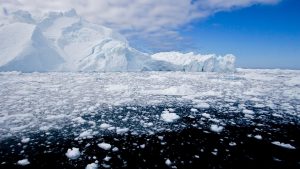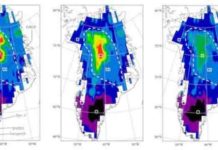
An international team that includes University of Montana researcher Jesse Johnson has learned that the Earth’s internal heat enhances rapid ice flow and subglacial melting in Greenland.
Johnson, a UM computer science professor and ice-sheet modeler, helped discover that about half of the ice-covered area in north-central Greenland rests on a thawed bed and that the meltwater is routed to the ocean through a dense hydrological network beneath the ice.
The work was published in the April 2016 issue of Nature Geoscience. “The strength of this paper is that many different lines of reasoning about data lead to the same conclusion,” Johnson said. “I was able to demonstrate that the ice velocities observed by satellite are nearly impossible to explain without the geothermal anomaly discovered here. Glaciologists have long suspected the anomaly exists, but this work quantifies its location and degree and explains why it is there.”
Johnson collaborated with a group led by Irina Rogozhina and Alexey Petrunin from the GFZ German Research Centre for Geosciences. The research has for the first time proved a strong coupling between the processes deep in the Earth’s interior with ice flow dynamics.
Deep under the Greenland Ice Sheet are regions of intense geothermal heat originating in the distant geological past. This heat causes Greenland’s ice to melt from below and flow rapidly. The new study identifies a west-to-east zone of northern Greenland having anomalously high heat.
Johnson said this anomaly explains observations from radar and ice core drilling data of widespread melting beneath the ice sheet and increased sliding at the base of the ice that drives the rapid ice flow over a distance of 750 kilometers from the summit area of the Greenland ice sheet to the North Atlantic Ocean.
The North Atlantic Ocean is an area of active plate tectonics. Between 35 million and 85 million years ago, tectonic processes moved Greenland over an area of abnormally hot mantle material now responsible for the volcanic activity of Iceland. The mantle material heated and thinned Greenland’s crust at depth, producing a strong geothermal anomaly that spans a quarter of the land area of Greenland.
“This ancient and sustained source of heat has created a region having warmer, softer ice and abundant subglacial meltwater, lubricating the base of the ice and making it flow rapidly,” Johnson said.
“The geothermal anomaly which resulted from the Icelandic mantle-plume tens of millions of years ago is an important motor for today’s hydrology under the ice sheet and for the high flow-rate of the ice,” Rogozhina said. “This in turn broadly influences the dynamic behavior of ice masses and must be included in studies of the future response to climate change.”
These secrets of Greenland’s past – hidden by an ice sheet as much as 3 kilometers deep – are now revealed by researchers using an innovative combination of computer models and satellite, airborne and in-situ data. The location and orientation of the zone of elevated geothermal heat flow corresponds to where Greenland moved over Iceland’s mantle plume and provides an independent test for models of the formation of the North Atlantic ocean, revitalizing a three-decades-long debate.
Johnson said the study demonstrates an unexpected link between the deep geothermal history of the Earth and ice sheet dynamics. It shows that the controls on ice sheet dynamics span a huge range of timescales, from the month-by-month changes of the ice cover to the multimillion-year epochs over which the Earth’s mantle and tectonic plates evolve.
Note: The above post is reprinted from materials provided by The University of Montana.









